 What do you do with a cat that you know is destined to die?
What do you do with a cat that you know is destined to die?
It’s part of life – for all of us, feline, human, everything in between, including my failed attempt at growing a pot of purple and white pansies indoors. But for some, the Final Moment is a bit more obvious than it is for others. Unfortunately, that means that we also have to advocate for them when we are certain – to prove to folks who only see them for 15 minutes every six or 12 months – because we know they’ve given us – their humans – the message. THAT message.
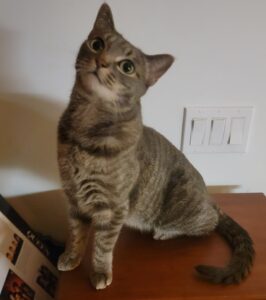 A cat who is ready to pass will let you know. In some ways, it is subtle. The dimmed light in their eyes. The cessation of usual sleeping places in favor of spots easier to reach. A limp. A lump. A poop log in the wrong place. Loss of interest in the things they once loved. The signs are minuscule but also meaningful. Maybe they’ll still happily eat a treat, but their physical pain leaves them incapable of moving from one spot to the next.
A cat who is ready to pass will let you know. In some ways, it is subtle. The dimmed light in their eyes. The cessation of usual sleeping places in favor of spots easier to reach. A limp. A lump. A poop log in the wrong place. Loss of interest in the things they once loved. The signs are minuscule but also meaningful. Maybe they’ll still happily eat a treat, but their physical pain leaves them incapable of moving from one spot to the next.
No two cats are the same when it comes to The End.
Knowing when a cat is ready to go to the Rainbow Bridge has become something of a specialty to me. Between Hospice Fostering and my own personal rule of adopting cats that are at least 10 years old, I have many little wooden boxes with engraved golden labels and sealed bags of ashes inside.
It is the hardest skill I have ever had to learn; it came with years upon years of training, observing, and following the instincts that I get when I look into the eyes of a cat that I love with all of my heart and soul.
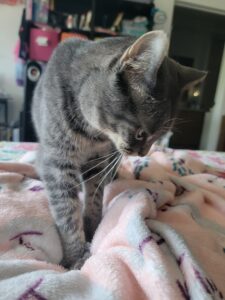 Enter Rocky – a beautifully long and lanky gray tabby – who has no idea he was born with kidneys incompatible with life. Rocky is a Tabby’s Place cat – a Hospice/Forever Foster; he lives with me, my husband, stepdaughter, elder cat Oreo (an inheritance from a beloved family member), and Zelda (missing a foot).
Enter Rocky – a beautifully long and lanky gray tabby – who has no idea he was born with kidneys incompatible with life. Rocky is a Tabby’s Place cat – a Hospice/Forever Foster; he lives with me, my husband, stepdaughter, elder cat Oreo (an inheritance from a beloved family member), and Zelda (missing a foot).
Zelda holds Badge #1 for Neighborhood Watch. Her job is to yell at the grackles and chickadees as she sits in the windowsill. Oreo is the unofficial Human Resources representative for Neighborhood watch and cares not for the goings on outside; unfortunately, by the time this post reaches your eyes, he will be over the Rainbow Bridge. The aforementioned advocacy took precedence here. The mind may be intact, but the body is not. Therein lies the struggle – how do we know when a cat is “ready”?
Alongside Zelda, Rocky was given Badge #2. He observes the grackles and chickadees, though he does not yell as much. In fact – he rarely yells.
Rocky is a gentle boy; gentle enough that his nickname has become ‘Gentle Boy’. The loudest I’ve ever heard him was after returning from a week-long vacation. Once he knew he had me alone, he let out a long, loud meow.
To Rocky, I am The One; while in the bathroom unpacking my toothbrush, I heard a very distinct voice.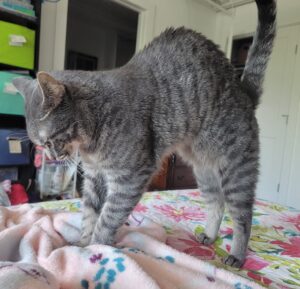
“Meow?!” Rocky – who rarely makes a peep – let out the longest, loudest meow I’d ever heard from him. And I knew, in that moment, that he truly missed me. He missed our routines.
I am his love. His whole world.
My husband is too big for him. For some reason, he does not like large men.
My stepdaughter is too rambunctious for him. For some reason, he does not like energetic movement.
Oreo is too grumpy for him. For some reason, he does not like impatient old cats.
Zelda – well, Zelda and Rocky do get along. Most of the time. About six months apart in age, they are almost like litter mates. They often curl up together in the closet and snooze in a pile of legs and paws and tails. Occasionally someone gets their face or rump groomed by the other. (And for some reason, pull all of my socks out of the sock bin. Investigation of the culprit is in progress.)
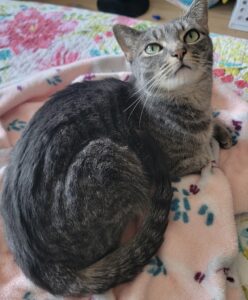 Each morning, my big, scary husband wakes up and leaves the room. The moment I wake up and take a sip of water as I check my phone for the time, Rocky is on the bed – slowly approaching me with his beautiful green gaze, quiet purring, and making biscuits on the blankets with his long, skinny legs and gangly toes. His favorite blanket is a soft pink throw adorned with sloths in various poses.
Each morning, my big, scary husband wakes up and leaves the room. The moment I wake up and take a sip of water as I check my phone for the time, Rocky is on the bed – slowly approaching me with his beautiful green gaze, quiet purring, and making biscuits on the blankets with his long, skinny legs and gangly toes. His favorite blanket is a soft pink throw adorned with sloths in various poses.
He knows I am all his, at least for that brief twinge of time. And my husband knows – leave us undisturbed. Let Rocky bask in the adoration of the weird little rainbow-haired lady who brought him home to care for him in his end-stage, despite his unawareness that he was born in end-stage, that end-stage is guaranteed, and that we’ve somehow already surpassed the expectancy for when that time would come.
Those biscuits he makes are a blessing, one gangly-toed paw at a time, and remind me of why I do what I do.
So often I hear the same thing – “I don’t know how you can foster a cat knowing they’re going to die.” – in some form or another, it’s always the same question. Always the same confounded musing. And then I watch him pick a favorite toy out of the toy bin – a little plastic spring – and carry it in his mouth up to the main bedroom.
My answer is always the same.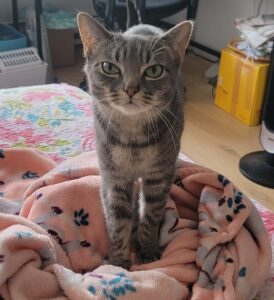
The price I pay in heartbreak is less than the bounty I receive in love.
Rocky is a testament to that standard. That is the reason I foster hospice cats and adopt the elderly and the broken. My heart grows fuller, my soul is filled, and despite the number of ugly tears I will cry, I will come away from it with the love and memories and silly photos of a time where – even if just briefly – a terminally ill cat was able to live in a home as if nothing were wrong.
Every time he hops up on the bed in the morning, greeting me with an almost imperceptible purr, making his gentle biscuits on my blanket as he gives me slow blinks with those owlish eyes, I am pre-paid boundlessly in love for the emotional cost I will eventually bear.
That is enough – and that is what you do with a cat that you know is destined to die.
